
Helpful Tips for Fishing (5)
Everyone Wonder What Color to Tie For When Steelhead Fishing?
Steelheaders know water conditions are everything.
My son turned 16 and thought, what better way than to take him on a fishing trip in Northern Ontario. After some discussions with Mike Borger (Canada Fishing Guide), he had me convinced to spend the extra time and money on a fly-in trip. Boy was Mike right!
GETTING THERE
White River Air is located just North of the town that was home to the real Winnie the Pooh - White River. Home base is located on Tukanee Lake, not far from White River (6-8 minute drive away if you are staying in White River). Upon arrival, we were greeted by Brandy and given the run-down of the trip and timing. After unloading our equipment and food at the dock, the guys loaded our single prop Beaver. Our flight was amazing, calm waters and smooth sailing so to speak when cresting the tree tops. The view of Northern Ontario from that Beaver gave new meaning to just how vast the province is. Fully of tea-stained lakes, streams, bogs and lush green untouched forests and aquatic vegetation.
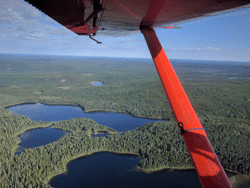
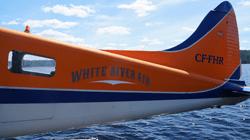
THE OUTPOST
From up high, the scenery was breathtaking, particularly for someone who had never flown in Northern Ontario. With the outpost in sight, our pilot pulled back on the throttle as we decended to Lake Hambleton. As we flew over the lake, I made a mental note of the various changes in depth and possible fishing hotspots on the lake. Surprisingly, for the number of people that come to Hambleton Lake each year, there is not much information out there about where to fish. Most people rely on the pilots for their intel, but my mission was two fold. First, getting my son on the water for some quality father-son time, second was to test an new fishing app I have been developing for the past 2 years called FISHBUOY. If you want to see our hotspots where we caught fish plus water, weather, moon phase, and primary bait color, download the free app visit www.fishbuoy.com.
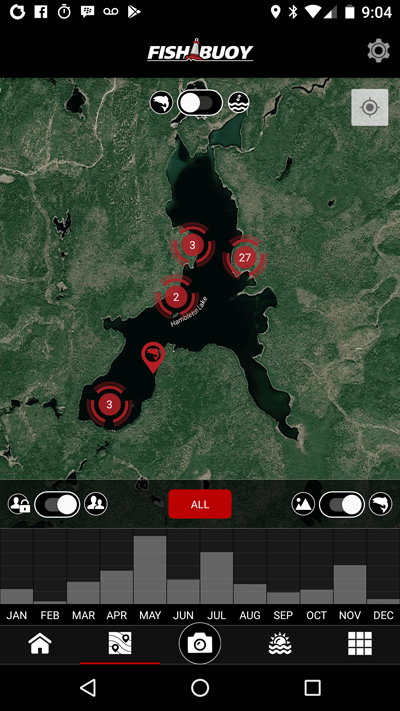
The outpost itself had three lund 15ft boats with 9.9 Yamaha outboards. All the boats had small leaks so bringing a pair of rubber boots made that easy to deal with. We never had a problem with starting the engine and plenty of fuel was supplied for both the boats, generator and water pump. Yes, the outpost, which had four bunk beds, a kitchen with fridge, dining area and a shower with hot water, also had electricity for lights. The pump located near the waters edge was used to pump water from the lake to barrels that provided water pressure and water for the shower and sinks. NOTE: you must prime the water pump so make sure the pilot shows you how.
The washroom was an outhouse situated not far from the building, but far enough back. It had a screen to reduce mosquito's. Overall, Hambleton's outpost was well equiped.
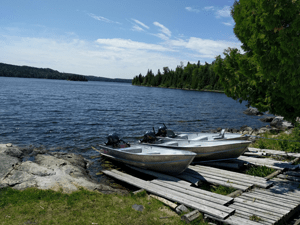

LAKE HAMBLETON
The lake is actually not as tea-stained as some of the lakes we had flown over. In fact, I would place the water color similar to Bay of Quinte (minus the polyps bloom you see in the spring). Water temps were in the low-to-mid 70's. The outpost is situated pretty much in the center of the west shore of the lake, which makes it nice to access both ends of the lake quickly. The north (top) part of the lake is shallow with a sandy mud base. There is a small channel leading to a shallow back bay that we never had time to investigate. Though the northern portion of the lake looked inviting for Pike, we did not see any. However, I would imagine in early spring this would be a great place to target Pike post-spawn. The southern most reach of the lake was very promising with huge individual rock bolders and rocky outcrops that extended well in to the lake from the shoreline. Be careful, as they are not obvious! These structures were ideal for Pike and Walleye and we managed to land a number of fish at this end of the lake. Noteworthy is a small, scenic water fall - but be aware, there are huge leeches swimming around that occasionally latched on, as my son once found out. To the east, there is a single arm with a very shallow, muddy/silt base. Some aquatic vegatation and rocky shores would make this a great place to target post-spawning Pike as well. We did not fish it simply because it was too shallow. However, where the main lake meets the east arm, you will find a rocky outcrop - this held many walleye. Suggest you spend some time fishing the outcrop, in addition to the inner bays that connect. This is where we had our best luck by far. With a dominant south-south-east wind, this shoreline hosted bait and schools of walleye, likely due to the shoreline distrubance caused from the wind. As most fishermen know, fishing the rough side of the lake is generally most productive and this was certainly the case during our stay.
Lake Hambleton also has an island not far from the outpost. This island has a rocky outcrop (south-west corner) that extends halfway to the west shoreline. We mostly fished the Southern and Western portions of the island and took many Northerns off the Southeast corner of the island as well.
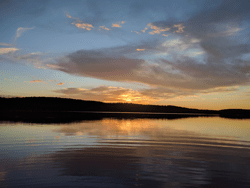
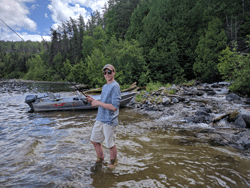
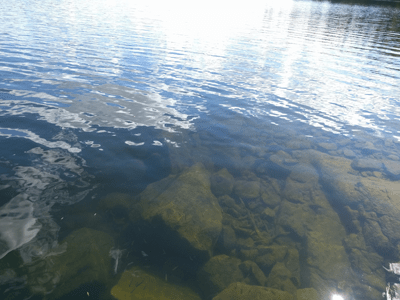
THE FISHING
We had read information about the lake highlighting Walleye as the dominant species followed by North Pike. So, as any good walleye fishermen would do, I loaded up on a variety of jigs, various sizes and a multitude of colors with chartreuse being the dominant color. Supplemental to this, we stocked up on large Len Thomson spoons such as the yellow-red five of diamonds, chartreuse-orange five of diamonds, and Mepps Cyclops spoons and inline spinners. By far, the gold Mepps Cyclops caught more pike than any other bait we casted, and from the photos in this article, you can see we had a full arsenal to select from. For walleye, the dominant bait was.... a jig tipped with a minnow - that's right a minnow! Though we caught plenty of fish on jigs tipped with worms (white Mister Twister tail, black dots), we consistently caught more fish with minnows. During shore lunches, we even put a minnow under a float right off the dock and caught a number of walleye and pike. 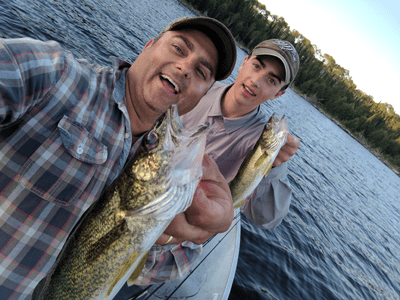
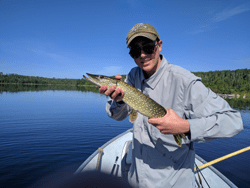
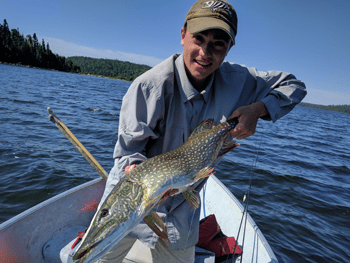
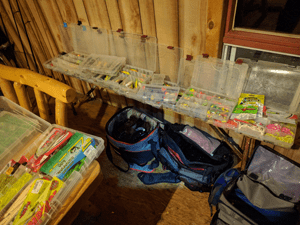
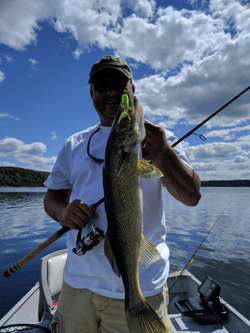
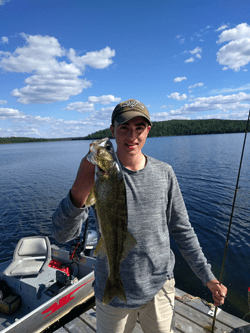
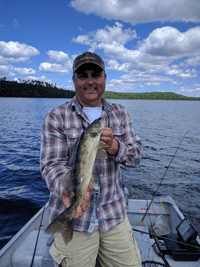
Why minnows? We learned from our pilot that the lake was experiencing it's annual Mayfly hatch - and it was in full force right when we where there. We saw many fish surfacing and upon closer investigation, and confirmation, whitefish were coming to the surface to feed on the Mayflies. But, this also meant the walleye were also feeding on them which was confirmed when cleaning fish for shore lunch. According to the pilot, during this time, you have a 1-2 day window of less-than-typical fishing on the lake. He was right however we countered the Mayfly hatch with live minnows we caught from our dock. This was a learning for me. Always bring a minnow trap!
Overall, fishing was great, we hooked into numerous walleye in the 15"-18" range and a Northern Pike over 31". We had many follows from Northern Pike that I would estimate in the 42" -45" range. We had shore lunch everyday and to note, the island across from the outpost is a great place to relax, fish and enjoy your catch.
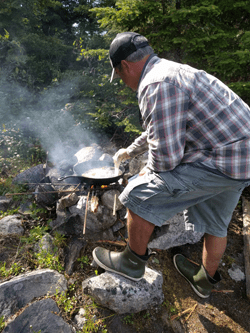
Top Walleye Bait: 3/8, 1/4 ounce Northland jigs, chartreuse/white color, Mister Twister tail (with black spots), tipped with minnow or worm.
Top Pike Bait: Mepps Cyclops gold, medium size spoon
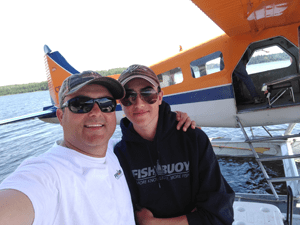
CONCLUSING REMARKS
Overall, White River Air provided a wonderful and professional fly-in experience. They provided a friendly service from booking to departure. The facilities and equipment were all in full working order which made for a very comfortable stay. And of course, the fish was amazing! We will return soon.
I would highly recommend you contact White River Air as they have many other outposts to experience.
Contact:
Brandi MacLachlan
White River Air
PO Box 220
White River, ON P0M 3G0
Email: This email address is being protected from spambots. You need JavaScript enabled to view it.
Year-round: (807) 822-222
Telephone
(807) 822-2223 fax
http://whiteriverair.com/
Ontario fishermen are so fortunate to be surrounded by thousands of rivers and lakes - including the largest freshwater lakes in the world - our Great Lakes! Recently I had the opportunity to head across the border to the USA and fish the south shore of Lake Erie. The season opens earlier for smallmouth bass in New York state and hosts numerous tournaments running from May-August. Before heading out, it is important to gauge several well-known environmental factors when fishing for smallmouth bass - wind direction (historical and forecasted), cloud cover, water temperatures, and pressure changes.
For this time of the year on Lake Erie, I prefer winds from the south or southeast, 10-18 knots. Offshore winds minimize wave heights even under higher wind conditions. Lake Erie is known for changing rapidly, making fishing undesirable and unsafe so plan the day right. Throwing out a drift sock or using the Minnkota helps to slow down and control the drift so your baits remain on the bottom.
Water temps, even surface temps can offer some indication to smallmouth activity. Once getting to the 50's you can expect more action. This is not a perfect science for numerous reasons but most guides and charters captains will always head to warmer surface water temps. If heading out, watch your temperature!
Smallmouth will hit under most cloud cover types when fishing water deeper than 25ft. Still, my preference is to stick with the now discoutinued Storm Thunderblade lure - silver/black or rainbow green/silver. Not really sure why this lure was discontinued but it is a great bait that gets you down deep, provides great vibrations, and is better than dragging a tube. A close cousin is the Kamooki Smart Fish.
Atmospheric pressure changes are thought to impact feeding behaviour of bass. Though not proven, many fishermen have experienced a "lock-jaw" effect when pressure rapidly changes from high-to-low, or low-to-high. From my experience, it is this "change in pressure" that does in fact slow down feeding - but not stop it completely. I tend to slow down retrieval rates, go with more natural colors, and even go with live bait to entice the bite. From my perspective, it is all about giving fish time to acclimate to the pressure change.
All in all, the day was great and we stored our fishing photos as waypoints using FISHBUOY Mobile. Next year, we will have the information accessible in FISHBUOY Mobile and FISHBUOY TripPlanner to help us find our spots and align our trip to the right fishing conditions.
Water turbidity whether in a lake, reservoir, river or stream, directly impact how and where we fish. Sometimes, water conditions are too murky and make it nearly impossible for fish to identify your bait in the water. Many fishermen have experienced the challenges around timing fishing trips to the right water conditions. Unfortunately, turbidity is not a frequently monitored water parameter and as a result, leaves fishermen guessing about how clear or how dirty their waters may be once getting to their spot. Using technology such as FISHBUOY allows fishermen to collect turbidity data while in the field and start to build a catalog of conditions that also helps fishermen make an educated guess about how wind direction, magnitude and amount of precipitation may influence water turbidity. Try these steps and start to learn your waters.
1) Open FISHBUOY App and take a photo of the water. Make sure to get some perspective on depth by either wading in to a safe depth and taking a photo of our wading boot - or take a photo of your outboard motor in the water. These will give you a sense of water turbidity based on what you see in the water.
2) FISHBUOY App automatically collects water and weather parameters and tags this information into each photo. This includes water level, water discharge, wind direction and speed, and the precipitation amount and more. In some case, even turbidity and water temperature is included but this is dependent on the available sensors on that water body.
3) Continue to take photos using the "Species" option to collect the relavent water and weather data. Simply use dummy data for species, size and bait color as this information is not necessary when trying to determine how weather may impact water turbidity.
Over time, you will begin to see how the photos in your gallery are impacted by weather.
Turbidity in a fishermens terminology is often used to describe how clear or dirty water is. For most freshwater sports fishermen, water clarity is extremely important because it directly influences decisions made on and off the water. Many fishermen, those wading, compare water clarity to visual depth until your wader boot is no longer visible. For example, a fisherman wading in a river would refer to water clarity in terms of feet or inches of "vis" or "visibility". This basically means, the visual distance you can see an object until it disappears from sight. This is important because most freshwater sports fish are visual feeds first. Similarly, fishermen in boats will also refer to feet of visibility. FISHBUOY Software taps into over 17,000 water monitoring stations, many of which, record turbidity. Looking at turbidity prior to heading out can drastically improve your chances of catching more fish.
Common fishing tactics related to water clarity/turbidity include:
1) Lure/bait color selection - Dirty water (>25NTU) often means brighter colors. Clear water oftens means smaller baits using more natural colors found in the environment.
2) Lure/bait scent - Dirty water makes fish rely more on their other senses, including scent. There are numerous fish scents on the market - try one out!
3) Lure sound/vibration - Dirty water often means attracting fish to your baits through the use of vibrating or sound producing lures. When in turbid waters, add a little extra sound to catch a fishes attention.
Paying attention to water conditions has helped me over the years when fishing for steelhead, salmon, pike, bass and even pan fish. Turbidity affects all species and is worth taking a quick look at FISHBUOY Online to know before you go. www.fishbuoy.com
Every spring and fall, steelheaders from the Great Lake Region prepare their gear in anticipation of the false-fall steelhead run, or post-spawn steelhead exodus back to the lake. This time of the year means paying attention to water conditions and matching bait size and color to water flow and turbidity. FISHBUOY not only helps fishermen to determine what the current water conditions are, FISHBUOY also provides steelheaders with this handy Spawn Tying Guideline that accounts for water turbidity, water velocity, number of eggs per sac, and spawn net color to use. Try it out and learn for yourself the importance of match your bait to water conditions.
|
QUESTIONS? Feel free to drop us a line - click here. One of our representatives will get back to you as soon as possible. |
|---|





